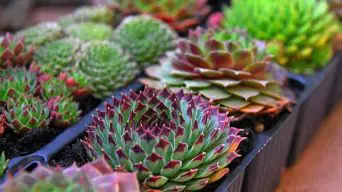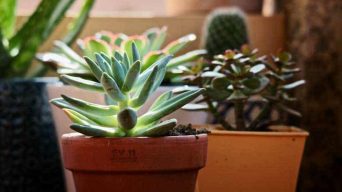Cacti are a popular choice for indoor plants because they’re easy to care for and come in various shapes and sizes.
An essential part of taking care of your cactus is being able to tell when it’s healthy and needs nurturing and when it’s not doing well and might need a little extra love.
Fortunately, there are several signs that you can look for to determine whether or not your cactus is healthy.
Here we will discuss how to tell if a cactus is healthy and how to keep it that way!
What Does a Healthy Cactus Look Like
To identify a healthy cactus, you need to understand the basic signs of a well-balanced plant.
Cactus plants have different ways of thriving, but there are some general things to look for to determine if your cactus is healthy and happy.
Below are some signs that your cactus is thriving and in good health.
Signs of a Healthy Cactus
To keep your cactus healthy, it is essential to identify when it is not doing well.
Here are some signs that a cactus is healthy:
The Cactus Has a Healthy, Green Color
A healthy cactus will have a deep, rich green color.
If the cactus is paler than normal or has patches of brown, it may not be healthy.
When cacti start to lose their color, it is often a sign that they are not getting enough light or water.
The Cactus Is Growing New Spines
If the cactus is healthy, it will grow new spines. This is a sign that the plant is thriving and doing well.
If the cactus does not have any new spines or has lost them, this may be a sign that something is wrong with the plant.
The Cactus Has a Healthy Root System
A healthy cactus will have a healthy root system.
If the roots are brown or mushy, this may be a sign that the cactus is overwatered.
If the roots are dry and brittle, this may be a sign that the cactus is underwatered.
The Cactus Has New Growth
If the cactus has new growth, this is a good sign.
New growth means that the plant takes in water and nutrients and grows well.
If there is no new growth, or if the new growth is wilted, this may be a sign that something is wrong with the cactus.
The Cactus Has Firm, Intact Skin
The skin of a healthy cactus should be firm and intact.
If the skin is cracked or peeling, this may be a sign that the cactus is not getting enough water.
Also, be on the lookout for pests and diseases. If the cactus has any of these problems, it is unhealthy and needs to be treated.
The Cactus Is Not Wilting
A healthy cactus should not be wilting.
If the cactus is wilting, it is not getting enough water or light.
If the cactus is wilted for an extended period, it may die.
The Cactus Is Producing Flowers
Cacti can produce flowers when they are healthy. If the cactus is growing flowers, this is a good sign.
If the cactus is not producing flowers, it doesn’t have the energy to do so, which may be a sign that something is wrong.
The Cactus Is Standing Upright
A healthy cactus will stand upright. If the cactus is leaning to one side or is not standing up straight, it may be a sign that something is wrong with the plant.
When a cactus is leaning, the soil is too wet or too dry.
Also, be on the lookout for pests that can make the cactus lean.
The Cactus Is Not Rotting
A healthy cactus should not be rotting.
If the cactus is rotting, there is a problem with the plant, and it needs to be treated.
Some of the signs of rot include black spots on the skin, white mold, and soft or mushy tissue.
What Does an Unhealthy Cactus Look Like
Now that you know how to identify a healthy cactus, it is essential to be able to identify an unhealthy cactus before it becomes too late.
A dying cactus will show many signs that it is not doing well.
An unhealthy cactus will have some or all of the following signs.
Signs of an Unhealthy Cactus
Identifying the signs of an unhealthy cactus is vital so that you can give the plant the care it needs to get better.
The following signs indicate that a cactus is not doing well:
The Cactus Is Wilting
One of the most obvious signs that a cactus is not doing well is if it starts to wilt.
If you see your cactus wilting, it means that it is not getting enough water.
Cacti need very little water, so if you see your cactus wilting, it is important to give it a drink right away.
The Cactus Is Drooping
If the cactus appears to be drooping, it might be getting too much water.
When a cactus gets too much water, the roots will start to rot, and the plant will start to droop.
You will need to stop watering the cactus for a little while to fix this.
The Cactus Is Brown or Black
If the cactus is brown or black, there is something wrong with it, and it needs your help.
Brown or black patches on a cactus can be a sign of rot, pests, or a disease.
The Cactus Is Leaning
If the cactus is leaning, it might mean that it is not getting underwatered or overwatered.
Leaning cacti can also be a sign that the pot is too big or too small for the plant.
The Spines Are Falling Out
If the spines are falling out, it might mean that the cactus is not getting enough sunlight.
Cacti need plenty of sunlight to stay healthy, so if the spines are falling out, you will need to move the cactus to a sunnier spot.
The Flowers Are Dying
If the flowers on the cactus are dying, it might mean that the plant is not getting enough water or sunlight.
To fix this, you will need to give the cactus more water and move it to a sunnier spot.
The Cactus Is Sagging
If the cactus is sagging, it might mean that it is not getting enough support.
When a cactus plant starts to sag, it means that the soil has become too wet, and the plant is beginning to rot.
You will need to repot the cactus in a pot with better drainage to fix this.
The Cactus Is Shriveling
If the cactus is shriveling, it might mean that it is not getting enough water or nutrients.
Shriveled cacti can also be a sign of pests or diseases.
The Cactus Smells Bad
If the cactus smells bad, it means there is something wrong with it.
A bad smell coming from a cactus plant can be a sign of root rot, pests, or a disease.
A rotting cactus will smell especially bad.
The Cactus Is Squishy
If the cactus is squishy, it might mean that it is rotting.
When a cactus starts to rot, it will become soft and squishy.
This can be a sign that the plant is in serious trouble and needs your help.
How to Keep a Cactus Healthy
One of the joys of cacti is how low-maintenance they are.
But even these hardy plants need a little love to stay healthy.
Knowing how to tell if a cactus is healthy and how to keep it that way is key to ensuring your plants thrive.
Here are a few tips on how to keep your cactus healthy:
Water Your Cactus Sparingly
Overwatering is the most common way to kill a cactus plant.
Cacti, as most succulent plants, don’t need much water, so only water them when the soil feels dry to the touch.
In general, watering once every one to two weeks is plenty.
Use the Right Soil
Cacti prefer loose, well-draining soil. A cactus soil mix, which you can find at most garden stores, is perfect.
You can also make your own mix by combining one part potting soil, one part sand, and one part perlite.
Protect From Cold Weather
Most cacti don’t like cold weather, so move them indoors if the temperature drops below 50 degrees F.
Cactus plants need a temperature range of 55 to 80 degrees F to thrive.
Avoid Direct Sunlight
Cacti need plenty of sunlight, but direct sunlight can be too harsh.
Try to place your cactus in a spot with partial shade where it will get indirect bright light.
Cacti need at least four hours of sunlight a day to stay healthy.
Fertilize Sparingly
Cacti don’t need much fertilizer, so only fertilize them during the growing season (spring through summer).
Use a balanced cactus fertilizer or a 20-20-20 water-soluble fertilizer. Only fertilize once every month or two.
Watch for Pests and Diseases
Cacti can be susceptible to pests and diseases.
Watch for signs of trouble, such as infestations of spider mites, mealybugs, or aphids. Also, you need to watch for disease symptoms such as wilting or brown spots.
If you notice any problems, take action to treat the plant right away.
Prune if Necessary
Prune off any dead or damaged branches to keep the cactus looking neat and healthy.
Pruning also helps keep the plant from becoming too tall or spindly.
Removing old growth also encourages new buds and flowers to form.
Repot Every Two to Three Years
Cacti grow slowly, so they don’t need to be repotted often.
But it would be best if you repotted them every two to three years into a pot that’s one size larger.
Be sure to use a soil mix that’s suited for cacti.
Final Thoughts
If you are unsure how to tell if a cactus is healthy or not, there are some key things to look out for.
Be observant of the color of the cactus’ skin, its overall shape, and size, as well as how much water it is retaining.
If your cactus does show any signs of distress, don’t hesitate to take action and give it the care it needs.
A healthy cactus is a beautiful addition to any home, and with these simple tips, you can ensure that your cactus stays healthy and happy for years to come.







